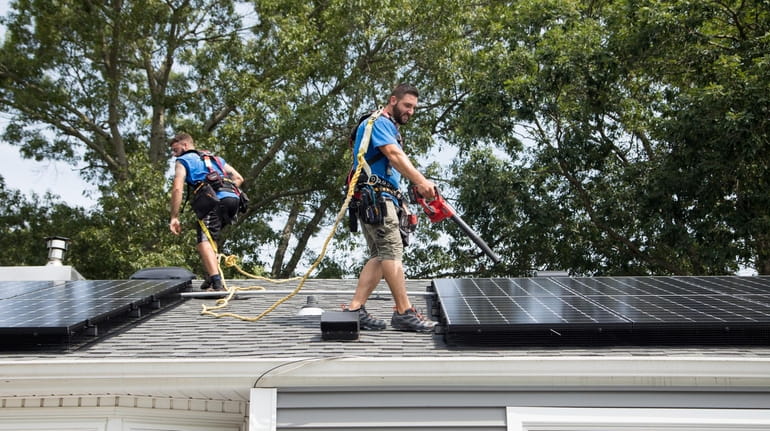LI grid upgrades for wind, solar power could top $1.5 billion

Utilities and state regulators have proposed a series of wind and solar projects to help distribute the massive amounts of energy planned for the power grid by 2035. Credit: Barry Sloan
New York State plans to integrate major wind and solar energy projects onto the power grid could entail $1.5 billion in upgrades on Long Island, but don’t reach for your wallet just yet: LIPA is making the case that the cost must be borne by ratepayers statewide.
In state filings over the past two months, utilities such as LIPA and state regulators have proposed a series of projects to help distribute the massive amounts of green energy planned for the grid by 2035.
Most of the biggest and costlier projects involve fortifying cable transmission lines or building new ones — in some cases nearly tripling the capacity of Long Island’s electric output from 138,000 volts to 345,000 volts. The state also has plans for generating some 9,000 megawatts of offshore wind off the South Shore of Long Island and beyond. New York State says its 9,000 megawatts of wind power alone will power 6 million homes.
The upgrades would allow the state to move that energy more easily from wind farms chiefly off the Long Island and New England coast, while eliminating bottlenecks that have restricted the statewide transmission grid — bottlenecks that result mainly from insufficient transmission capacity on the power lines. The plan also envisions thousands of megawatts of additional solar power, a greater use of batteries to store energy for periods the wind isn’t blowing, and an offshore electric grid network to make the system more resilient.
A recently released study of statewide grid upgrade needs indicated that "additional transmission from Long Island to the mainland will be needed by 2035." Without the expansion from Long Island's anticipated 3,000-megawatt portion, the study indicates, there would be a need for "curtailments," or intentional power outages, needed to help balance the system, according to the report by the state Department of Public Service and the New York State Energy Research and Development Authority.
"The study shows this need arises as interconnecting more than 3,000 megawatts of offshore wind generation to Long Island would cause curtailments." What's more, transmitting more than 3,000 megawatts through Long Island "may be inevitable" as the total need for wind power swells beyond the state's projection of 9,000 megawatts.
The study also envisions that greater "bulk transmission" of electricity from upstate to Long Island (and New York City) "could become cost effective after 2035 as the grid approaches zero emissions."
The study also envisions that offshore network of substations and transmission could help by providing more "reliable and resilient" offshore wind energy.
Tom Falcone, chief executive of LIPA, said the authority has already made a strong case to state regulators that the projects must be paid for by ratepayers across the state who will benefit from the upgrades, and not just Long Island ratepayers.
He cautioned that state regulators "have not made a decision yet" on the upgrades, but stressed "the projects are only going to go forward with statewide funding." That would mean rate increases for customers in all regions of the state that will benefit, and not just Long Islanders, who already face cost increases of, for instance, $1.58 a month just for the 130-megawatt South Fork Wind farm, when it is completed by 2023. NYSERDA has already contracted for some 4,000 megawatts of offshore wind, much of it to be located off Long Island’s South Shore.
It’s not as though Long Islanders won’t pay their fair share, however. Increases in rates for Long Islanders will come over time as the projects begin, but, if LIPA gets its way, they will be lower than if LIPA were developing the transmission upgrades to serve just the Long Island market. In this case, since the bigger upgrades will benefit customers in New York, Westchester and other regions of the state, as the power is moved through Long Island to those regions, the costs will be shared by all those who benefit, LIPA says. Traditionally, project developers had paid these costs to connect their projects to local grids, and recouped costs through rate increases to customers in that service area.
Falcone said the projects are needed because of the large increases of power expected on the grid and the existing systems’ limitations.
"As you put more and more offshore wind onto the grid, think of it as water pipe. At some point you reach the limit, so in order to have more offshore wind you have to upgrade the pipe."
Among the proposals being considered for phase one and two of the projects are $1.3 billion in upgrades to connect 3,000 megawatts of offshore wind power to the LIPA grid. It would involve building a 345,000-volt circuit from LIPA’s newly built Shore Road substation in Glenwood to the Ruland Road substation in Melville. That project, proposed for 2025 to 2035, has an estimated cost of $647 million. LIPA and PSEG are already in the process of a separate $513 million upgrade of the South Shore transmission grid.
The plan would also include conversion of an existing 138,000-volt transmission line to 345,000 volts, from East Garden City to New Bridge Road in Levittown, then onto Ruland Road. That project has an estimated price tag of $221 million.
The plan also calls for a new interconnection line between the LIPA and Con Edison system at a cost yet to be determined; various upgrades of existing 69,000-volt cables for over $200 million; and installation of new equipment on the grid for another $200 million.
Solar power projects will also necessitate upgrades across the Long Island power grid, including upgrades of substations in Wading River, Yaphank and Babylon; construction of a new substation at Doctors Path in Riverhead; and numerous other equipment enhancements for a total of $167 million.
Those upgrades come atop phase one improvements that are either already part of LIPA’s capital budget, or have already begun. It includes upgrading transformers and switching gear and substations to higher voltages. The projects, expected to be completed by 2024, have a combined price tag of some $351 million and will bring increased capacity of some 520 megawatts onto the grid.
Correction: The Shore Road substation is in Glenwood Landing. An earlier version of the story had an incorrect location.
Getting Ready for Wind Power
Proposed Long Island grid upgrades for 2024-2035:
- Convert the existing 138,000-volt transmission backbone from East Garden City to Melville, to 345,000 volts. $221 million
- Add a new 345,000-volt circuit from Glenwood to Melville. $647 million
- Install new 345,000-volt interconnection to the Con Ed system: not available
- Install voltage control devices: $200 million
- Upgrade existing 69,000-volt circuits: $206 million

